Economic Report: GDP, Unemployment, and Inflation Analysis
VerifiedAdded on 2024/04/24
|10
|1585
|95
Report
AI Summary
This report provides an analysis of key economic indicators, including Gross Domestic Product (GDP), unemployment, and inflation, within the framework of aggregate demand and supply. It defines economic growth and equilibrium stability, elaborating on the components of GDP, types of unemployment (frictional, structural, cyclical), and causes of inflation, including the demand-pull and cost-push effects. The report also includes a comparative analysis of the United States, China, and Australia based on their GDP, unemployment rates, and inflation rates as of 2017. It concludes by summarizing the relationships between these macroeconomic factors and their impact on economic stability and growth.

ECONOMICS
Paraphrase This Document
Need a fresh take? Get an instant paraphrase of this document with our AI Paraphraser
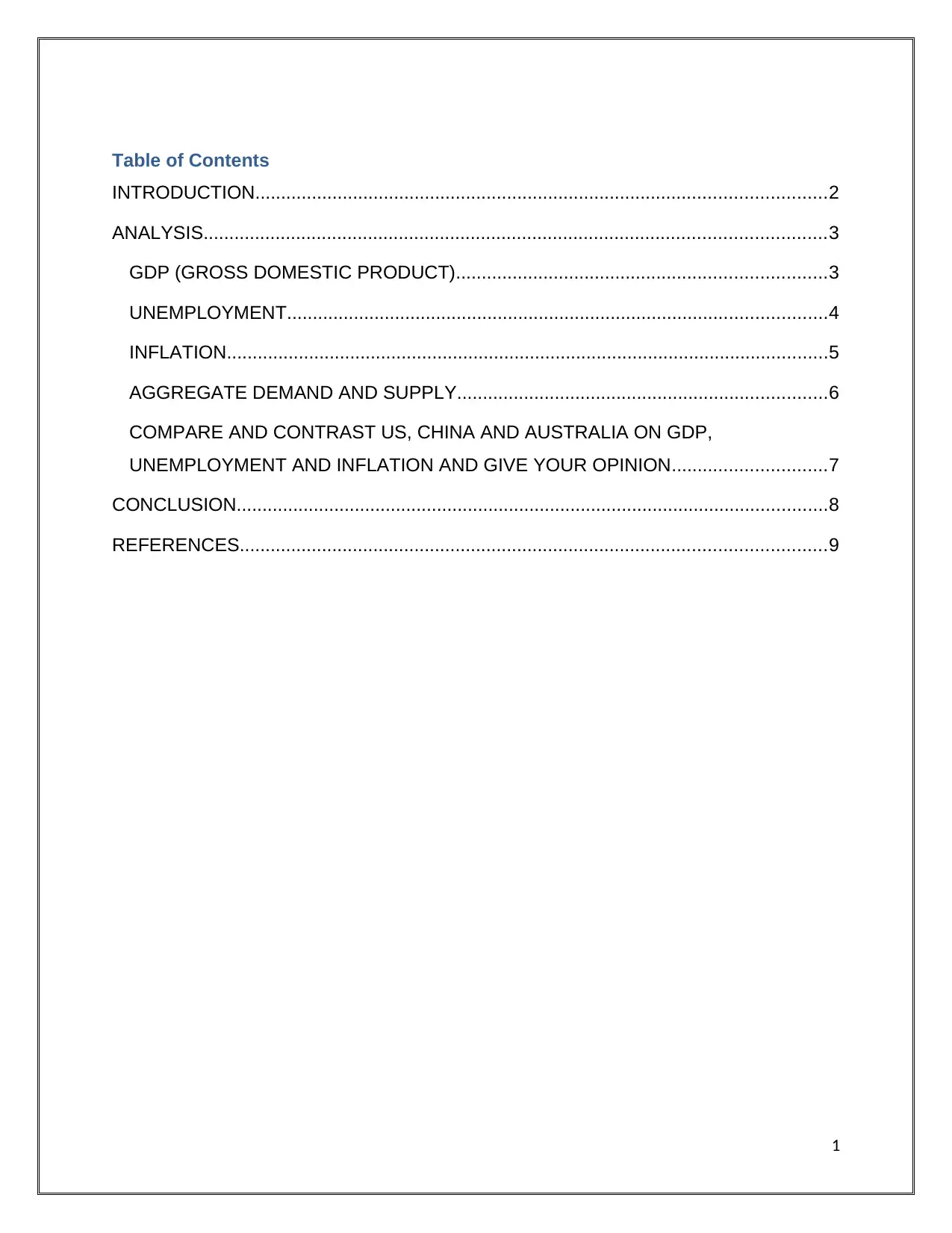
Table of Contents
INTRODUCTION...............................................................................................................2
ANALYSIS.........................................................................................................................3
GDP (GROSS DOMESTIC PRODUCT)........................................................................3
UNEMPLOYMENT.........................................................................................................4
INFLATION.....................................................................................................................5
AGGREGATE DEMAND AND SUPPLY........................................................................6
COMPARE AND CONTRAST US, CHINA AND AUSTRALIA ON GDP,
UNEMPLOYMENT AND INFLATION AND GIVE YOUR OPINION..............................7
CONCLUSION...................................................................................................................8
REFERENCES..................................................................................................................9
1
INTRODUCTION...............................................................................................................2
ANALYSIS.........................................................................................................................3
GDP (GROSS DOMESTIC PRODUCT)........................................................................3
UNEMPLOYMENT.........................................................................................................4
INFLATION.....................................................................................................................5
AGGREGATE DEMAND AND SUPPLY........................................................................6
COMPARE AND CONTRAST US, CHINA AND AUSTRALIA ON GDP,
UNEMPLOYMENT AND INFLATION AND GIVE YOUR OPINION..............................7
CONCLUSION...................................................................................................................8
REFERENCES..................................................................................................................9
1
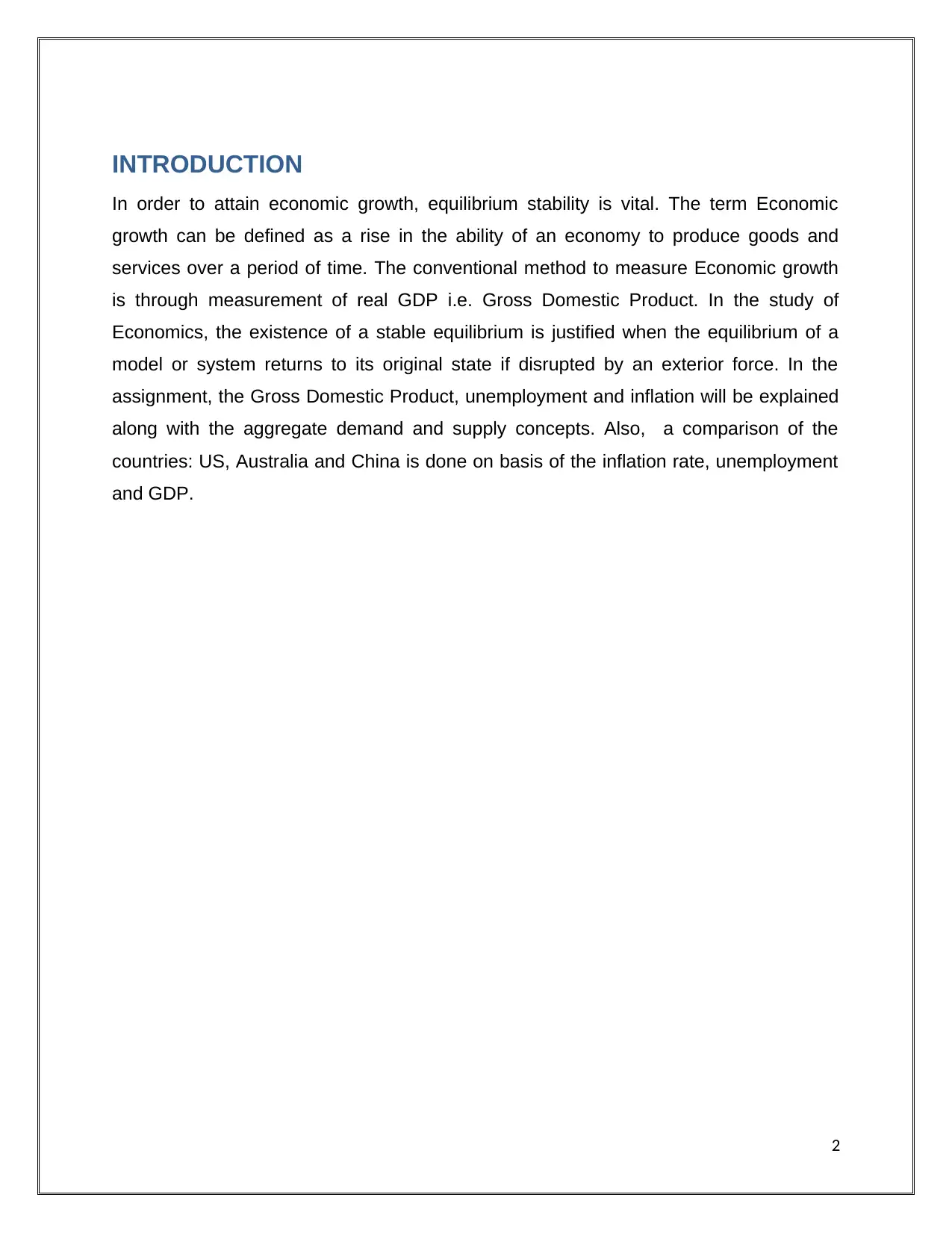
INTRODUCTION
In order to attain economic growth, equilibrium stability is vital. The term Economic
growth can be defined as a rise in the ability of an economy to produce goods and
services over a period of time. The conventional method to measure Economic growth
is through measurement of real GDP i.e. Gross Domestic Product. In the study of
Economics, the existence of a stable equilibrium is justified when the equilibrium of a
model or system returns to its original state if disrupted by an exterior force. In the
assignment, the Gross Domestic Product, unemployment and inflation will be explained
along with the aggregate demand and supply concepts. Also, a comparison of the
countries: US, Australia and China is done on basis of the inflation rate, unemployment
and GDP.
2
In order to attain economic growth, equilibrium stability is vital. The term Economic
growth can be defined as a rise in the ability of an economy to produce goods and
services over a period of time. The conventional method to measure Economic growth
is through measurement of real GDP i.e. Gross Domestic Product. In the study of
Economics, the existence of a stable equilibrium is justified when the equilibrium of a
model or system returns to its original state if disrupted by an exterior force. In the
assignment, the Gross Domestic Product, unemployment and inflation will be explained
along with the aggregate demand and supply concepts. Also, a comparison of the
countries: US, Australia and China is done on basis of the inflation rate, unemployment
and GDP.
2
⊘ This is a preview!⊘
Do you want full access?
Subscribe today to unlock all pages.

Trusted by 1+ million students worldwide
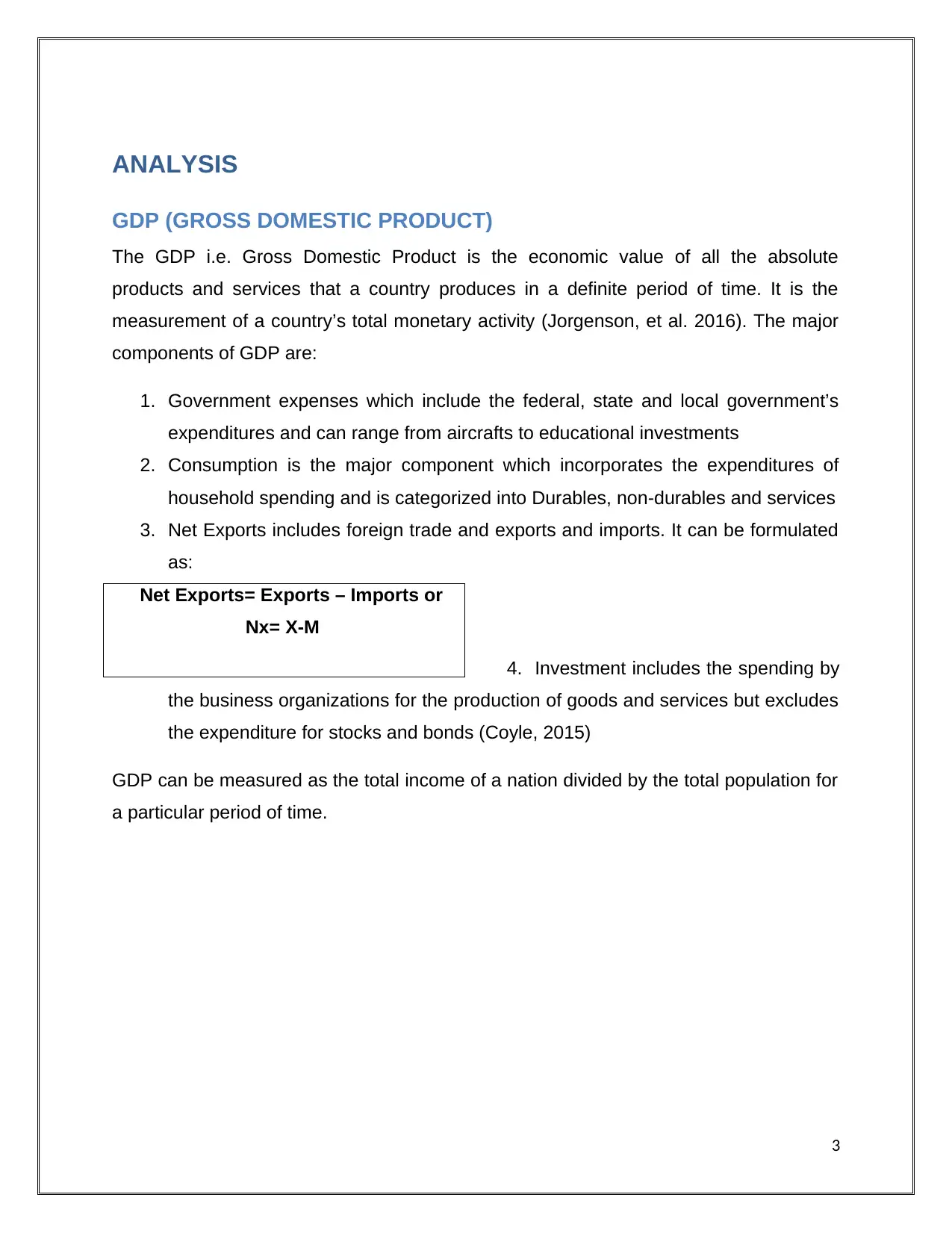
ANALYSIS
GDP (GROSS DOMESTIC PRODUCT)
The GDP i.e. Gross Domestic Product is the economic value of all the absolute
products and services that a country produces in a definite period of time. It is the
measurement of a country’s total monetary activity (Jorgenson, et al. 2016). The major
components of GDP are:
1. Government expenses which include the federal, state and local government’s
expenditures and can range from aircrafts to educational investments
2. Consumption is the major component which incorporates the expenditures of
household spending and is categorized into Durables, non-durables and services
3. Net Exports includes foreign trade and exports and imports. It can be formulated
as:
4. Investment includes the spending by
the business organizations for the production of goods and services but excludes
the expenditure for stocks and bonds (Coyle, 2015)
GDP can be measured as the total income of a nation divided by the total population for
a particular period of time.
3
Net Exports= Exports – Imports or
Nx= X-M
GDP (GROSS DOMESTIC PRODUCT)
The GDP i.e. Gross Domestic Product is the economic value of all the absolute
products and services that a country produces in a definite period of time. It is the
measurement of a country’s total monetary activity (Jorgenson, et al. 2016). The major
components of GDP are:
1. Government expenses which include the federal, state and local government’s
expenditures and can range from aircrafts to educational investments
2. Consumption is the major component which incorporates the expenditures of
household spending and is categorized into Durables, non-durables and services
3. Net Exports includes foreign trade and exports and imports. It can be formulated
as:
4. Investment includes the spending by
the business organizations for the production of goods and services but excludes
the expenditure for stocks and bonds (Coyle, 2015)
GDP can be measured as the total income of a nation divided by the total population for
a particular period of time.
3
Net Exports= Exports – Imports or
Nx= X-M
Paraphrase This Document
Need a fresh take? Get an instant paraphrase of this document with our AI Paraphraser
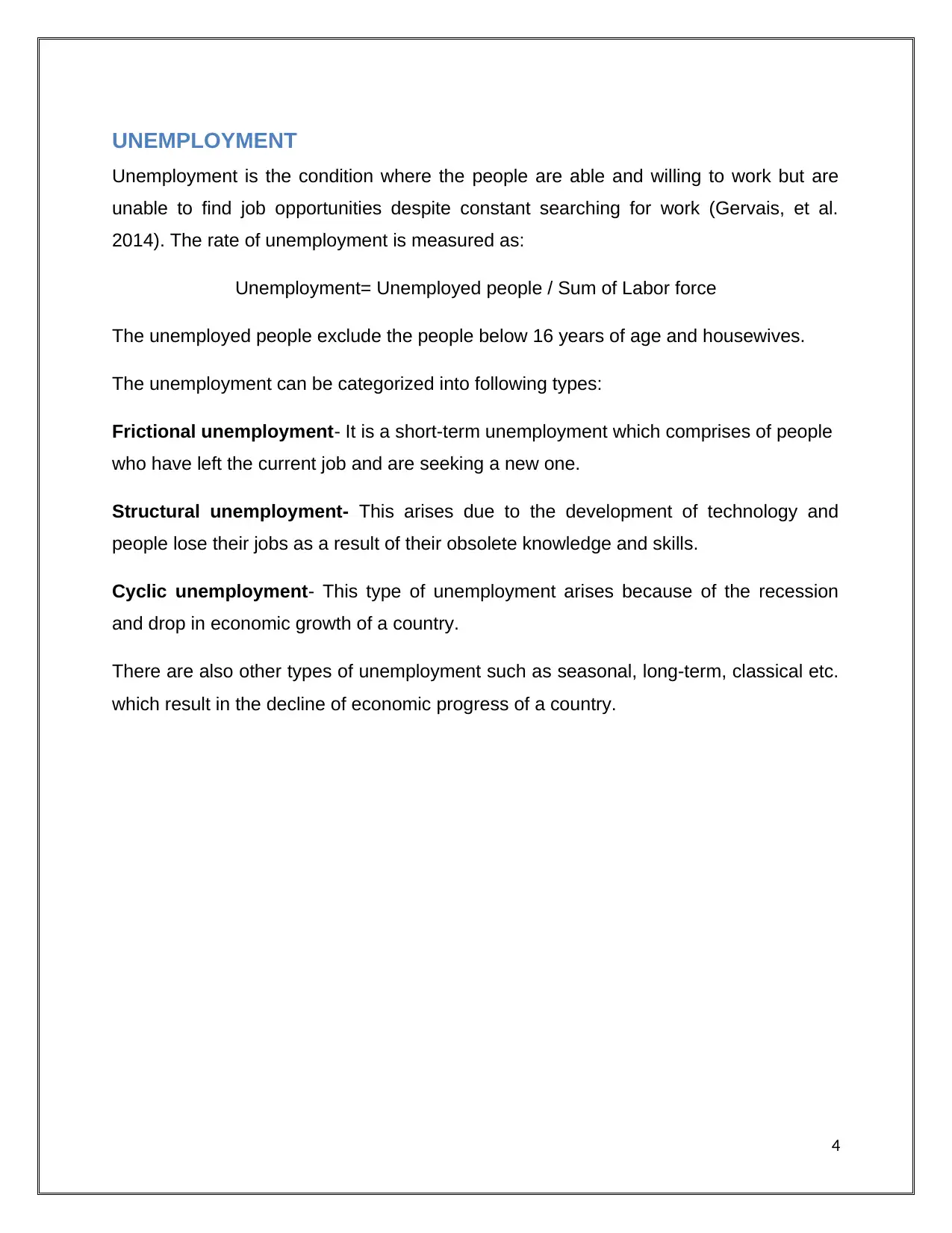
UNEMPLOYMENT
Unemployment is the condition where the people are able and willing to work but are
unable to find job opportunities despite constant searching for work (Gervais, et al.
2014). The rate of unemployment is measured as:
Unemployment= Unemployed people / Sum of Labor force
The unemployed people exclude the people below 16 years of age and housewives.
The unemployment can be categorized into following types:
Frictional unemployment- It is a short-term unemployment which comprises of people
who have left the current job and are seeking a new one.
Structural unemployment- This arises due to the development of technology and
people lose their jobs as a result of their obsolete knowledge and skills.
Cyclic unemployment- This type of unemployment arises because of the recession
and drop in economic growth of a country.
There are also other types of unemployment such as seasonal, long-term, classical etc.
which result in the decline of economic progress of a country.
4
Unemployment is the condition where the people are able and willing to work but are
unable to find job opportunities despite constant searching for work (Gervais, et al.
2014). The rate of unemployment is measured as:
Unemployment= Unemployed people / Sum of Labor force
The unemployed people exclude the people below 16 years of age and housewives.
The unemployment can be categorized into following types:
Frictional unemployment- It is a short-term unemployment which comprises of people
who have left the current job and are seeking a new one.
Structural unemployment- This arises due to the development of technology and
people lose their jobs as a result of their obsolete knowledge and skills.
Cyclic unemployment- This type of unemployment arises because of the recession
and drop in economic growth of a country.
There are also other types of unemployment such as seasonal, long-term, classical etc.
which result in the decline of economic progress of a country.
4
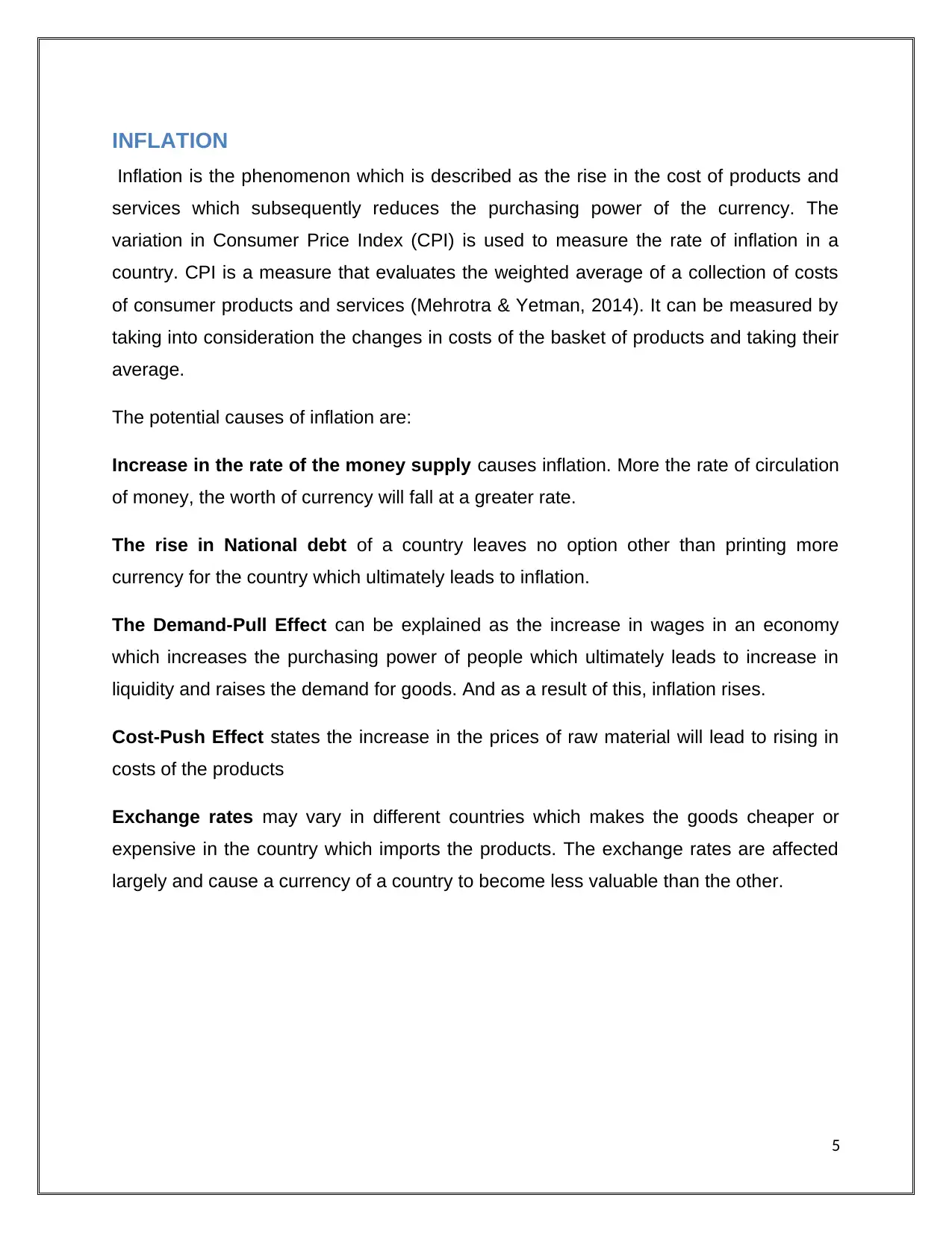
INFLATION
Inflation is the phenomenon which is described as the rise in the cost of products and
services which subsequently reduces the purchasing power of the currency. The
variation in Consumer Price Index (CPI) is used to measure the rate of inflation in a
country. CPI is a measure that evaluates the weighted average of a collection of costs
of consumer products and services (Mehrotra & Yetman, 2014). It can be measured by
taking into consideration the changes in costs of the basket of products and taking their
average.
The potential causes of inflation are:
Increase in the rate of the money supply causes inflation. More the rate of circulation
of money, the worth of currency will fall at a greater rate.
The rise in National debt of a country leaves no option other than printing more
currency for the country which ultimately leads to inflation.
The Demand-Pull Effect can be explained as the increase in wages in an economy
which increases the purchasing power of people which ultimately leads to increase in
liquidity and raises the demand for goods. And as a result of this, inflation rises.
Cost-Push Effect states the increase in the prices of raw material will lead to rising in
costs of the products
Exchange rates may vary in different countries which makes the goods cheaper or
expensive in the country which imports the products. The exchange rates are affected
largely and cause a currency of a country to become less valuable than the other.
5
Inflation is the phenomenon which is described as the rise in the cost of products and
services which subsequently reduces the purchasing power of the currency. The
variation in Consumer Price Index (CPI) is used to measure the rate of inflation in a
country. CPI is a measure that evaluates the weighted average of a collection of costs
of consumer products and services (Mehrotra & Yetman, 2014). It can be measured by
taking into consideration the changes in costs of the basket of products and taking their
average.
The potential causes of inflation are:
Increase in the rate of the money supply causes inflation. More the rate of circulation
of money, the worth of currency will fall at a greater rate.
The rise in National debt of a country leaves no option other than printing more
currency for the country which ultimately leads to inflation.
The Demand-Pull Effect can be explained as the increase in wages in an economy
which increases the purchasing power of people which ultimately leads to increase in
liquidity and raises the demand for goods. And as a result of this, inflation rises.
Cost-Push Effect states the increase in the prices of raw material will lead to rising in
costs of the products
Exchange rates may vary in different countries which makes the goods cheaper or
expensive in the country which imports the products. The exchange rates are affected
largely and cause a currency of a country to become less valuable than the other.
5
⊘ This is a preview!⊘
Do you want full access?
Subscribe today to unlock all pages.

Trusted by 1+ million students worldwide
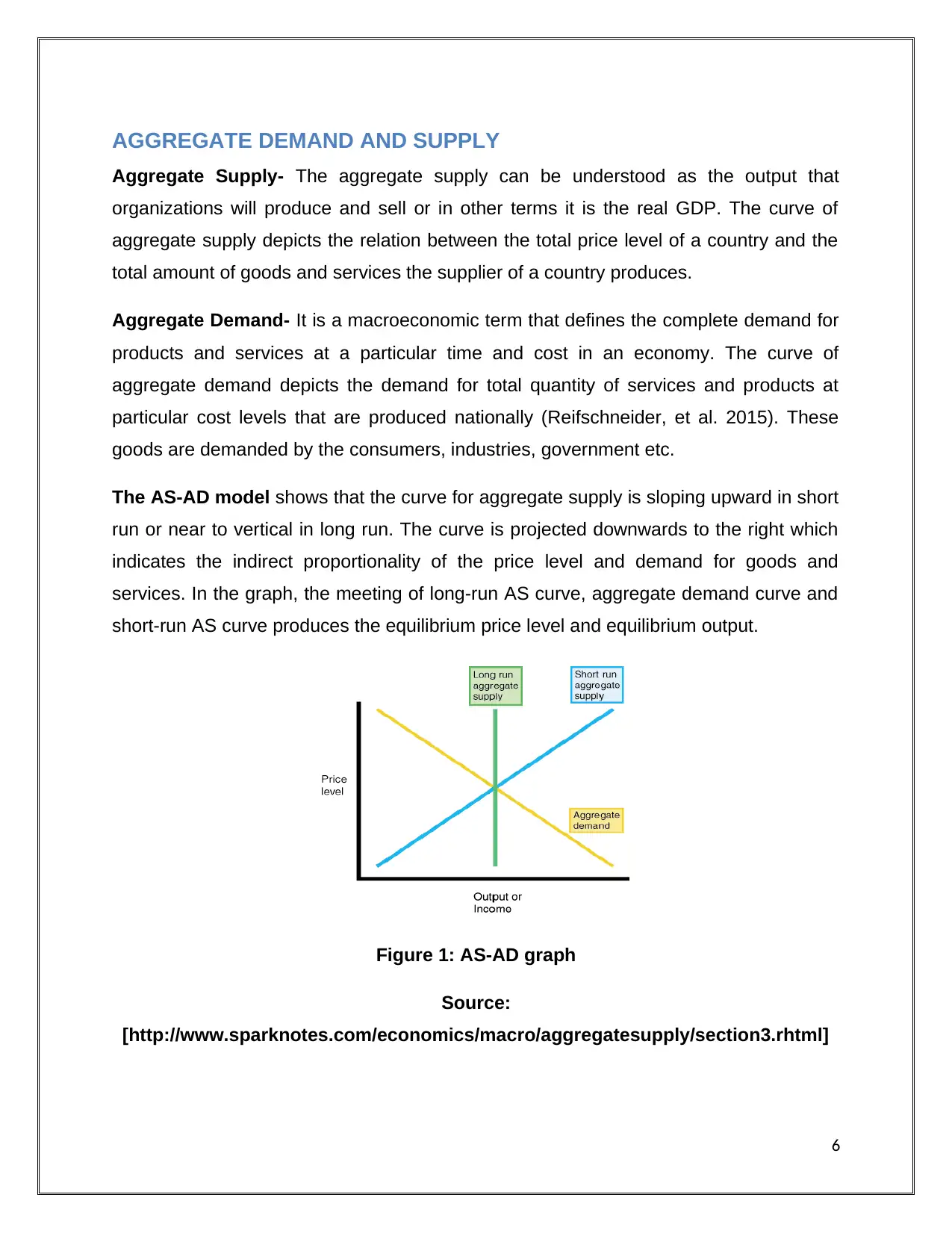
AGGREGATE DEMAND AND SUPPLY
Aggregate Supply- The aggregate supply can be understood as the output that
organizations will produce and sell or in other terms it is the real GDP. The curve of
aggregate supply depicts the relation between the total price level of a country and the
total amount of goods and services the supplier of a country produces.
Aggregate Demand- It is a macroeconomic term that defines the complete demand for
products and services at a particular time and cost in an economy. The curve of
aggregate demand depicts the demand for total quantity of services and products at
particular cost levels that are produced nationally (Reifschneider, et al. 2015). These
goods are demanded by the consumers, industries, government etc.
The AS-AD model shows that the curve for aggregate supply is sloping upward in short
run or near to vertical in long run. The curve is projected downwards to the right which
indicates the indirect proportionality of the price level and demand for goods and
services. In the graph, the meeting of long-run AS curve, aggregate demand curve and
short-run AS curve produces the equilibrium price level and equilibrium output.
Figure 1: AS-AD graph
Source:
[http://www.sparknotes.com/economics/macro/aggregatesupply/section3.rhtml]
6
Aggregate Supply- The aggregate supply can be understood as the output that
organizations will produce and sell or in other terms it is the real GDP. The curve of
aggregate supply depicts the relation between the total price level of a country and the
total amount of goods and services the supplier of a country produces.
Aggregate Demand- It is a macroeconomic term that defines the complete demand for
products and services at a particular time and cost in an economy. The curve of
aggregate demand depicts the demand for total quantity of services and products at
particular cost levels that are produced nationally (Reifschneider, et al. 2015). These
goods are demanded by the consumers, industries, government etc.
The AS-AD model shows that the curve for aggregate supply is sloping upward in short
run or near to vertical in long run. The curve is projected downwards to the right which
indicates the indirect proportionality of the price level and demand for goods and
services. In the graph, the meeting of long-run AS curve, aggregate demand curve and
short-run AS curve produces the equilibrium price level and equilibrium output.
Figure 1: AS-AD graph
Source:
[http://www.sparknotes.com/economics/macro/aggregatesupply/section3.rhtml]
6
Paraphrase This Document
Need a fresh take? Get an instant paraphrase of this document with our AI Paraphraser
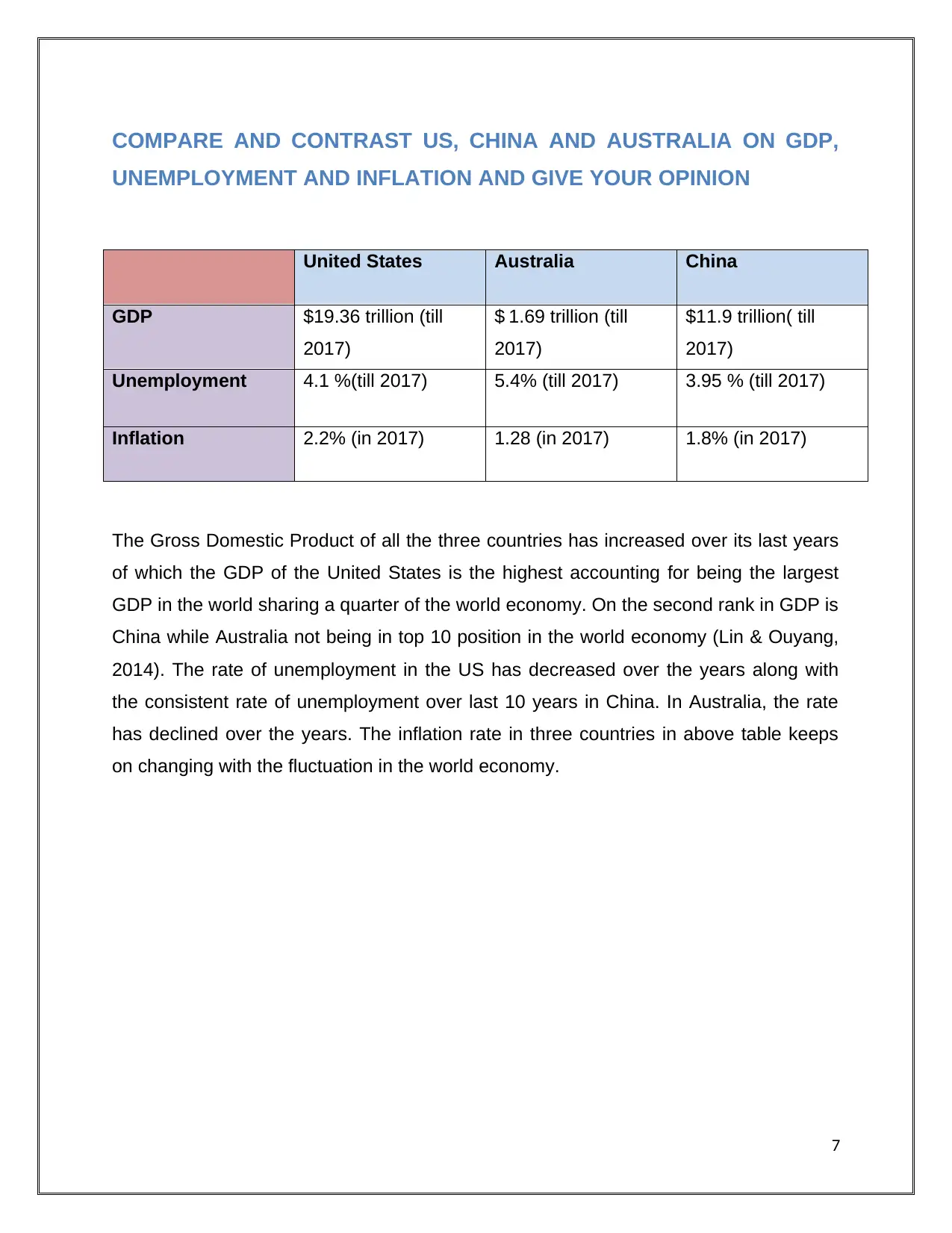
COMPARE AND CONTRAST US, CHINA AND AUSTRALIA ON GDP,
UNEMPLOYMENT AND INFLATION AND GIVE YOUR OPINION
United States Australia China
GDP $19.36 trillion (till
2017)
$ 1.69 trillion (till
2017)
$11.9 trillion( till
2017)
Unemployment 4.1 %(till 2017) 5.4% (till 2017) 3.95 % (till 2017)
Inflation 2.2% (in 2017) 1.28 (in 2017) 1.8% (in 2017)
The Gross Domestic Product of all the three countries has increased over its last years
of which the GDP of the United States is the highest accounting for being the largest
GDP in the world sharing a quarter of the world economy. On the second rank in GDP is
China while Australia not being in top 10 position in the world economy (Lin & Ouyang,
2014). The rate of unemployment in the US has decreased over the years along with
the consistent rate of unemployment over last 10 years in China. In Australia, the rate
has declined over the years. The inflation rate in three countries in above table keeps
on changing with the fluctuation in the world economy.
7
UNEMPLOYMENT AND INFLATION AND GIVE YOUR OPINION
United States Australia China
GDP $19.36 trillion (till
2017)
$ 1.69 trillion (till
2017)
$11.9 trillion( till
2017)
Unemployment 4.1 %(till 2017) 5.4% (till 2017) 3.95 % (till 2017)
Inflation 2.2% (in 2017) 1.28 (in 2017) 1.8% (in 2017)
The Gross Domestic Product of all the three countries has increased over its last years
of which the GDP of the United States is the highest accounting for being the largest
GDP in the world sharing a quarter of the world economy. On the second rank in GDP is
China while Australia not being in top 10 position in the world economy (Lin & Ouyang,
2014). The rate of unemployment in the US has decreased over the years along with
the consistent rate of unemployment over last 10 years in China. In Australia, the rate
has declined over the years. The inflation rate in three countries in above table keeps
on changing with the fluctuation in the world economy.
7
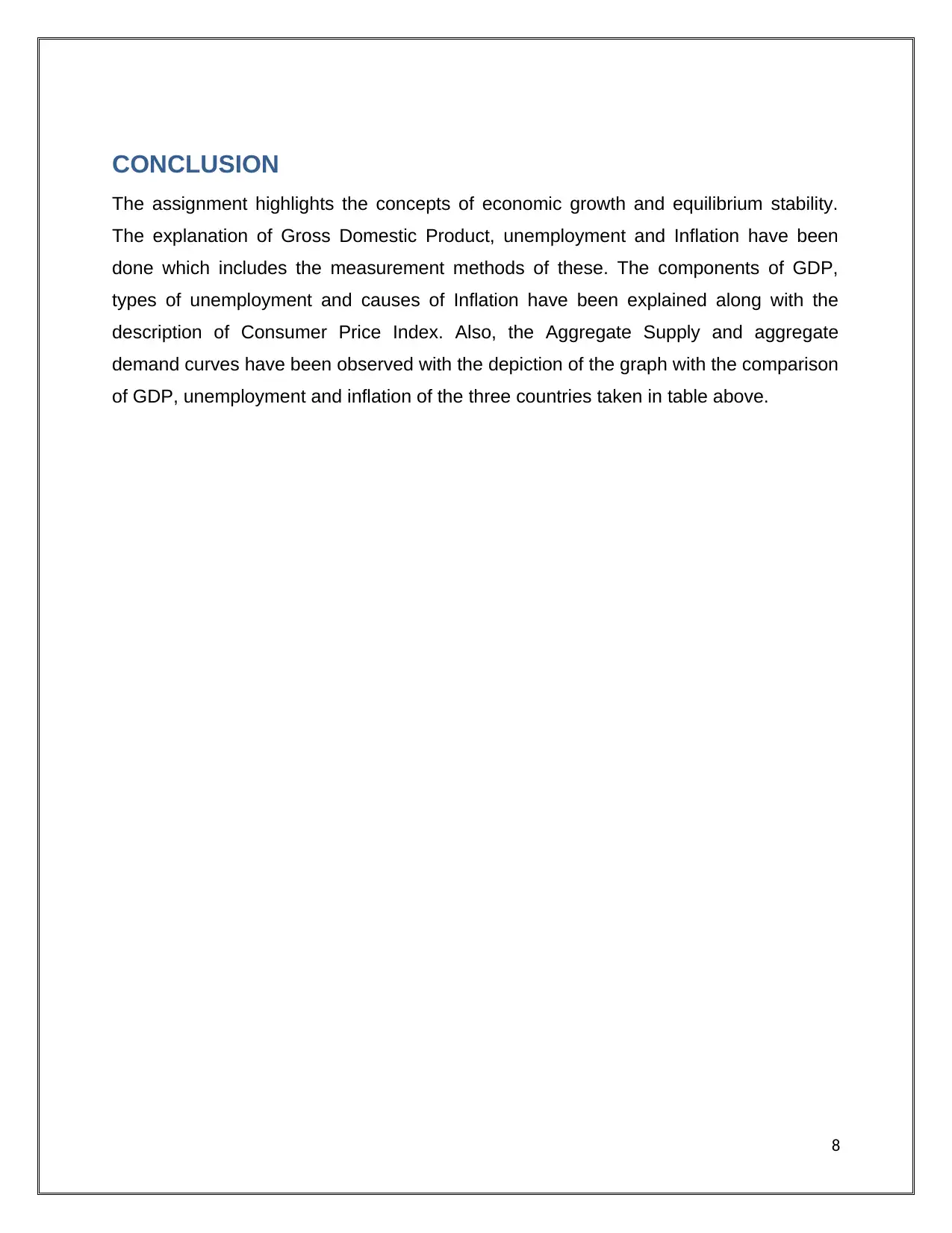
CONCLUSION
The assignment highlights the concepts of economic growth and equilibrium stability.
The explanation of Gross Domestic Product, unemployment and Inflation have been
done which includes the measurement methods of these. The components of GDP,
types of unemployment and causes of Inflation have been explained along with the
description of Consumer Price Index. Also, the Aggregate Supply and aggregate
demand curves have been observed with the depiction of the graph with the comparison
of GDP, unemployment and inflation of the three countries taken in table above.
8
The assignment highlights the concepts of economic growth and equilibrium stability.
The explanation of Gross Domestic Product, unemployment and Inflation have been
done which includes the measurement methods of these. The components of GDP,
types of unemployment and causes of Inflation have been explained along with the
description of Consumer Price Index. Also, the Aggregate Supply and aggregate
demand curves have been observed with the depiction of the graph with the comparison
of GDP, unemployment and inflation of the three countries taken in table above.
8
⊘ This is a preview!⊘
Do you want full access?
Subscribe today to unlock all pages.

Trusted by 1+ million students worldwide
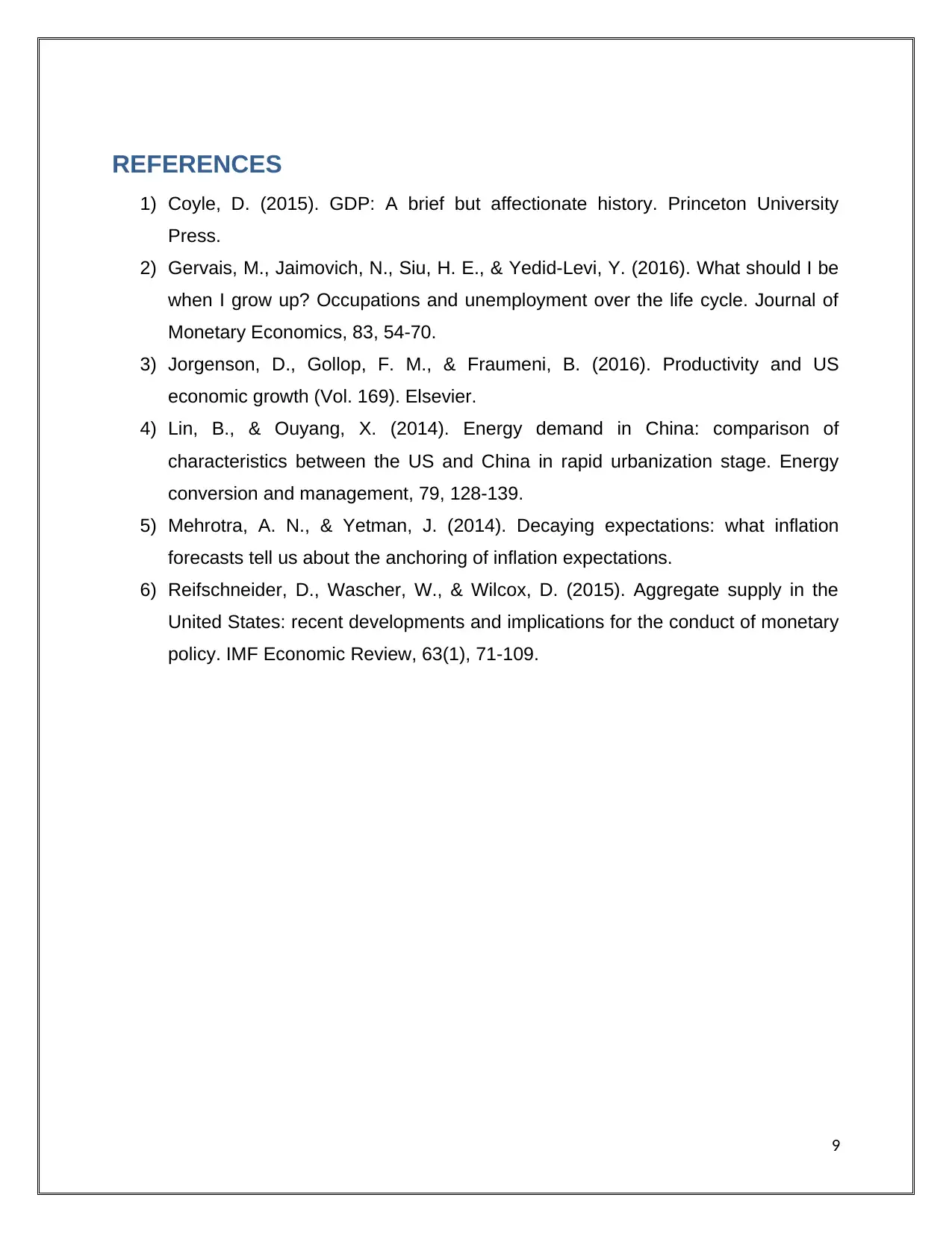
REFERENCES
1) Coyle, D. (2015). GDP: A brief but affectionate history. Princeton University
Press.
2) Gervais, M., Jaimovich, N., Siu, H. E., & Yedid-Levi, Y. (2016). What should I be
when I grow up? Occupations and unemployment over the life cycle. Journal of
Monetary Economics, 83, 54-70.
3) Jorgenson, D., Gollop, F. M., & Fraumeni, B. (2016). Productivity and US
economic growth (Vol. 169). Elsevier.
4) Lin, B., & Ouyang, X. (2014). Energy demand in China: comparison of
characteristics between the US and China in rapid urbanization stage. Energy
conversion and management, 79, 128-139.
5) Mehrotra, A. N., & Yetman, J. (2014). Decaying expectations: what inflation
forecasts tell us about the anchoring of inflation expectations.
6) Reifschneider, D., Wascher, W., & Wilcox, D. (2015). Aggregate supply in the
United States: recent developments and implications for the conduct of monetary
policy. IMF Economic Review, 63(1), 71-109.
9
1) Coyle, D. (2015). GDP: A brief but affectionate history. Princeton University
Press.
2) Gervais, M., Jaimovich, N., Siu, H. E., & Yedid-Levi, Y. (2016). What should I be
when I grow up? Occupations and unemployment over the life cycle. Journal of
Monetary Economics, 83, 54-70.
3) Jorgenson, D., Gollop, F. M., & Fraumeni, B. (2016). Productivity and US
economic growth (Vol. 169). Elsevier.
4) Lin, B., & Ouyang, X. (2014). Energy demand in China: comparison of
characteristics between the US and China in rapid urbanization stage. Energy
conversion and management, 79, 128-139.
5) Mehrotra, A. N., & Yetman, J. (2014). Decaying expectations: what inflation
forecasts tell us about the anchoring of inflation expectations.
6) Reifschneider, D., Wascher, W., & Wilcox, D. (2015). Aggregate supply in the
United States: recent developments and implications for the conduct of monetary
policy. IMF Economic Review, 63(1), 71-109.
9
1 out of 10
Related Documents
Your All-in-One AI-Powered Toolkit for Academic Success.
+13062052269
info@desklib.com
Available 24*7 on WhatsApp / Email
![[object Object]](/_next/static/media/star-bottom.7253800d.svg)
Unlock your academic potential
Copyright © 2020–2025 A2Z Services. All Rights Reserved. Developed and managed by ZUCOL.





